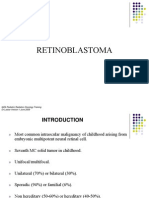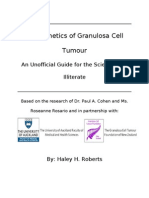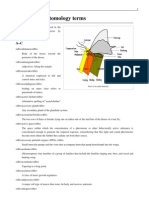Pathology of The Adnexa
Pathology of The Adnexa
Uploaded by
Arnella HutagalungCopyright:
Available Formats
Pathology of The Adnexa
Pathology of The Adnexa
Uploaded by
Arnella HutagalungOriginal Description:
Original Title
Copyright
Available Formats
Share this document
Did you find this document useful?
Is this content inappropriate?
Copyright:
Available Formats
Pathology of The Adnexa
Pathology of The Adnexa
Uploaded by
Arnella HutagalungCopyright:
Available Formats
Pathology of the
Adnexa
Dr. Soekimin, SpPA ; dr. Jessy Chrestella, SpPA
Dept. Patologi Anatomi Fakultas Kedokteran
Universitas Sumatera Utara
Medan 2010
Congenital Anomalies
Parametritis/Salphingitis
Ectopic pregnancy
Hydrosalpinx
Endometriosis
Para ovarian cyst
Carcinoma
Tubal common.
implantation allows early
placental development,
secretion of hCG, and
maintainance of the corpus
luteum.
Clinically features of a normal
pregnancy and the embryo
may also complete the early
embryonic stages of
development.
6
Inflam/Infections - rare
Ovarian cysts - common.
Non-Neoplastic
Follicular, epithelial, Luteal, etc.
Polycystic ovary syndrome
Ovarian Hyperstimulation synd.
Stromal Hyperplasia*
Endometriosis
Neoplasms
Benign (Cysts)
Malignant (Solid)
7
Serous cystadenoma
Cystoma
Papillary cystadenoma serosum
Surface papilloma
Serous adenofibroma
Serous cystadenofibroma
Pseudomucinous cystadenoma
Teratoma
- dermoid cyst
- Solid teratoma.
Granulosa cell tumor
Theca cell tumor
Arrhenoblastoma
Adrenal rest tumor
Dysgerminoma
Brenner tumor
Fibroma
Meigs syndrome
Sarcoma
Carcinoma (ad.Carcinoma)
Metastase carcinoma.
Cysts Common benign very large.
Solid rare malignant high mortality.
5
th
common cause of female cancer.
But carcinomas of the ovaries account for more
deaths than do cancers of all other female
malignancies together. (US stat).
Nulliparity & family history (BRCA) - Risk factor.
10
Amenorrhoea, hyperoestrogenism and
multiple follicular cysts.
Stromal hyperplasia & anovovulation
Important cause of infertility,
Endometrial hyperplasia/Carcinoma.
Clinical features:
Acne, alopecia, hirsutism,
Hypertension,
Insulin resistance, Type 2 DM.
Obesity Syndrome X.
11
12
Note: capsule thickening, cystic follicles without ova, thecal hyperplasia.
Metastases of hyperplastic
endometrium into ovary.
Retrograde menstruation
/Metaplasia.
Estrogen related.
Pouch of Douglas, the pelvic
peritoneum and the ovary -
'chocolate cysts'.
Periodic Pain, pelvic
inflammation, infertility.
13
14
Chocolate
Cysts
15
Chocolate
Cysts
Common, produce estrogen.
80% are benign, cystic, young (20-45)
20% are Malignant, solid - older (>40)
6% of all cancers in women.
50% deaths due to late detection.
The rule:
Cystic tumors are commonly benign
Solid tumors are commonly malignant.
16
Less clear than other
Null parity
Gonadal Dysgenesis
Family History
Ovarian cancer genes
BRCA1 (17q12) & BRCA2(13q12)
17
18
Classification of
Ovarian Tumours
Coelomic mesothelium
Serous (tubal)
Mucinous (Cx)
Endometrioid (End)
Transitional (UT)
90% of malignant tumors of ovary
Morphologically
Cystic Cystadenomas - Benign
Solid/cystic Cystadenoma - Borderline.
Solid Cystadenocarcinoma Malignant.
19
Frequently bilateral (30-66%).
75% benign/bord., 25% malignant.
One or few cysts, papillary/solid.
Tall columnar ciliated epithelium.
Papillary, solid, hemorrhage, necrosis or adhesions
malignancy.
Extension to peritoneum bad prog.
20
Less common 25%, very large.
Rarely malignant - 15%.
Multiloculated, many small cysts.
Rarely bilateral 5-20%.
Tall columnar, apical mucin.
Pseudomyxoma peritonei.
21
22
23
24
Borderline / Intermediate grade: note larger papillary growth.
25
multiloculated, 24cm cystic
ovary with attached fallopian
tube and uterus. benign
serous cystadenoma.
26
Note: papillary growths on inner surface
27
Note: Multi-loculated cystic tumor with some cysts showing hemorrhage.
28
Cuboidal simple Columnar Mucous
29
High grade: note large papillary growth extending and covering the cyst.
30
High grade: note large papillary growth extending and covering the cyst.
31
32
33
High grade: note large papillary growth extending and covering the cyst.
34
Infiltration
Papillary projections
35
36
Solid tumor with atypical cells forming sheets and gland like structures
without stroma. (back to back arrangement of glands)
Teratoma
Benign cystic (dermoid cyst)
Solid immature
Monodermal struma ovarii, carcinoid
Dysgerminoma
Yolksac tumor
Mixed germ cell tumor
37
38
39
40
41
42
Cartilage
Resp. Epith
Sweat Gl.
43
Sebaceous Gl.
Thyroid
M.A.L.T.
Cyst Lumen
44
Black arrow: Stratified squamous Keratinizing epithelium.
Blue arrow: Abundant sebaceous glands.
45
46
Any type of carcinoma, sarcoma or germ cell malignancy.
47
Torsion - infarction, perforation,
hemoperitoneum, and autoamputation
Bacterial infection of the cyst
Perforation - sudden acute abdomen, Slow
granulomatous peritonitis
Hemolytic anemia clears after removal.
<5% malignancy Sq. carcinoma.
48
49
50
51
52
53
Teenage / young, 2% of ovarian neoplasms.
1/2 of malignant germ cell neoplasms
Gonadal dysgenesis risk factor.
54
Note the pale brown appearance of the parenchyma, along with some central
collagenous scar. The gross and microscopic appearance of an ovarian dysgerminoma is
essentially same as a seminoma of the testis in a male.
55
56
Steroid cell tumour of the ovary. A well-circumscribed benign ovarian stromal
tumour that caused virilisation in the patient
57
Summary
Thank you
You might also like
- Benign Ovarian MassDocument39 pagesBenign Ovarian MassVidhi Chaudhary100% (2)
- Breast DiseasesDocument35 pagesBreast Diseasesheba1997bshNo ratings yet
- Phyllodes TumorDocument20 pagesPhyllodes TumorManuela KarinaaNo ratings yet
- Review Adnexal Masses Pregnancy Rcog PDFDocument6 pagesReview Adnexal Masses Pregnancy Rcog PDFRosália Coutada100% (1)
- Management of Abnormal Pap Smears PresentationDocument17 pagesManagement of Abnormal Pap Smears Presentationapi-210786702100% (2)
- Testicular Torsion: A Urological EmergencyDocument4 pagesTesticular Torsion: A Urological EmergencycorsaruNo ratings yet
- Lesions of CervixDocument56 pagesLesions of Cervixvandana100% (1)
- Medical and Surgical Management: of Uterine LeiomyomasDocument78 pagesMedical and Surgical Management: of Uterine LeiomyomasMarthinKolelupunNo ratings yet
- Tumor MarkersDocument43 pagesTumor MarkersSaroja Veeresh100% (1)
- Solitary Nodule of Thyroid DR.B.VDocument18 pagesSolitary Nodule of Thyroid DR.B.VpranapushpaNo ratings yet
- Abnormal UterineDocument23 pagesAbnormal Uterinehossam626No ratings yet
- CA Canal AnalDocument12 pagesCA Canal AnalGabriela Zavaleta CamachoNo ratings yet
- Colorectal CancersDocument162 pagesColorectal CancersSomto NwabuezeNo ratings yet
- Mass in Epigastrium-2Document37 pagesMass in Epigastrium-2brown_chocolate87643100% (1)
- Lecture Thyroid GlandDocument54 pagesLecture Thyroid GlandMarinaNo ratings yet
- Uterine Artery Malformation1Document9 pagesUterine Artery Malformation1venkayamma100% (1)
- CA Gall BladderDocument24 pagesCA Gall BladderTheoder RobinsonNo ratings yet
- Total Mesorectal Excision (Tme)Document19 pagesTotal Mesorectal Excision (Tme)Mehtab JameelNo ratings yet
- Endometrial Study by TVS and It's Correlation With Histopathology in Abnormal Uterine BleedingDocument12 pagesEndometrial Study by TVS and It's Correlation With Histopathology in Abnormal Uterine BleedingIOSRjournalNo ratings yet
- Mucinous Cystadenoma 0708Document12 pagesMucinous Cystadenoma 0708eosfield100% (1)
- UTUCDocument39 pagesUTUCShalini shree100% (1)
- Ectopic Pregnancy: by Amielia Mazwa Rafidah Obstetric and Gynecology DepartmentDocument43 pagesEctopic Pregnancy: by Amielia Mazwa Rafidah Obstetric and Gynecology DepartmentAlrick AsentistaNo ratings yet
- Hydatid Cyst Case ReportDocument10 pagesHydatid Cyst Case ReportAbdullah ZakiNo ratings yet
- Pathology of Female Genital System, 2024Document63 pagesPathology of Female Genital System, 2024Eslam HamadaNo ratings yet
- Lecture 6 Breach Presentation Transversal Oblique LieDocument51 pagesLecture 6 Breach Presentation Transversal Oblique Lietanmai nooluNo ratings yet
- 2015 Peer Assessment PAP SmearDocument5 pages2015 Peer Assessment PAP SmearRichardNo ratings yet
- AUB Classification - FIGODocument8 pagesAUB Classification - FIGOjeansabalosNo ratings yet
- 050 PPT - RetinoblastomaDocument61 pages050 PPT - RetinoblastomaAnastasia TjanNo ratings yet
- Biomarkers in Abnormal Uterine Bleeding: Precision Medicine in Assisted Reproductive Technologies Special IssueDocument12 pagesBiomarkers in Abnormal Uterine Bleeding: Precision Medicine in Assisted Reproductive Technologies Special IssueWahyuning PutriNo ratings yet
- Neck Swelling MotaweaDocument8 pagesNeck Swelling MotaweaMahmoud MotaweaNo ratings yet
- Benign and Malignant Tumors of Female Genital TractDocument14 pagesBenign and Malignant Tumors of Female Genital TractDimitrios PapadopoulosNo ratings yet
- Intra Abdominal 2009Document8 pagesIntra Abdominal 2009Shinta Dwi Septiani Putri WibowoNo ratings yet
- GCT For Dummies - Publish AbleDocument24 pagesGCT For Dummies - Publish AblepcrosleyNo ratings yet
- Algorithm For The Management of Heavy Menstrual BleedingDocument2 pagesAlgorithm For The Management of Heavy Menstrual BleedingNenny Yoanitha DjalaNo ratings yet
- Classification and Diagnosis of Endometrial Hyperplasia - UpToDateDocument24 pagesClassification and Diagnosis of Endometrial Hyperplasia - UpToDatenoor hyNo ratings yet
- Hysteroscopy Guidelines For Clinical Practice From The French College of Gynaecologists and ObstetriciansDocument9 pagesHysteroscopy Guidelines For Clinical Practice From The French College of Gynaecologists and ObstetriciansMaqsoodUlHassanChaudhary100% (1)
- 20acca - Urine CytologyDocument76 pages20acca - Urine CytologyMuhammad UmairNo ratings yet
- Reconstruction in Fournier GangreneDocument40 pagesReconstruction in Fournier GangreneAnggie MutmainnahNo ratings yet
- Grossing Uterus Presentation1Document19 pagesGrossing Uterus Presentation1jayesh saha100% (1)
- Portal HypertensionDocument13 pagesPortal HypertensionEmma100% (1)
- Cancer CervixDocument68 pagesCancer CervixhirenkamaliaNo ratings yet
- Endometriosis Adenomyosis Dr-IrabonDocument67 pagesEndometriosis Adenomyosis Dr-IrabonAbegail IbañezNo ratings yet
- Clinical Review - Full PDFDocument6 pagesClinical Review - Full PDFDewi WulansariNo ratings yet
- Septic Abortion PDFDocument4 pagesSeptic Abortion PDFmariachrismayaniNo ratings yet
- Uterus NeoDocument11 pagesUterus NeoHester Marie SimpiaNo ratings yet
- Benign Breast DisordersDocument42 pagesBenign Breast DisordersBRI KUNo ratings yet
- Spindle Cell LesionsDocument8 pagesSpindle Cell LesionsdrmanishsharmaNo ratings yet
- Gestational Trophoblastic Disease Pt2Document75 pagesGestational Trophoblastic Disease Pt2yurie_ameliaNo ratings yet
- By: Shrijan Timalsina, Samir Ghimire For-Dr - UMSD, DR - RJ Urosurgery Surgery DepartmentDocument30 pagesBy: Shrijan Timalsina, Samir Ghimire For-Dr - UMSD, DR - RJ Urosurgery Surgery DepartmentSamir GhimireNo ratings yet
- Early Treatment of Breast CancerDocument31 pagesEarly Treatment of Breast CancerZaayaNo ratings yet
- Tumor MarkersDocument7 pagesTumor MarkersironNo ratings yet
- Bladder Cancer LancetDocument11 pagesBladder Cancer LancetYesenia HuertaNo ratings yet
- Approach To Patients With Inguinoscrotal Masses: Section of Urology Department of Surgery The Medical CityDocument43 pagesApproach To Patients With Inguinoscrotal Masses: Section of Urology Department of Surgery The Medical CityKevin Eric SantosNo ratings yet
- 2015 Oncology CREOG Review PDFDocument76 pages2015 Oncology CREOG Review PDFRima HajjarNo ratings yet
- Surgical Principles of Rectal CancerDocument15 pagesSurgical Principles of Rectal CancerashentaxpayeeNo ratings yet
- AUB CompiledDocument72 pagesAUB CompiledDinesha PaniselvamNo ratings yet
- Singer and Monaghan's Cervical and Lower Genital Tract Precancer: Diagnosis and TreatmentFrom EverandSinger and Monaghan's Cervical and Lower Genital Tract Precancer: Diagnosis and TreatmentRating: 5 out of 5 stars5/5 (1)
- Gitelman's Syndrome 1Document4 pagesGitelman's Syndrome 1Arnella HutagalungNo ratings yet
- ICP AnnalsofhepatologyDocument4 pagesICP AnnalsofhepatologyArnella HutagalungNo ratings yet
- ACGGuideline Liver Disease and Pregnancy 2016 PDFDocument19 pagesACGGuideline Liver Disease and Pregnancy 2016 PDFArnella HutagalungNo ratings yet
- Body Fluids Balance: Atan Baas SinuhajiDocument33 pagesBody Fluids Balance: Atan Baas SinuhajiArnella HutagalungNo ratings yet
- Urinary Tract Infection: Infeksi Saluran KemihDocument35 pagesUrinary Tract Infection: Infeksi Saluran KemihArnella HutagalungNo ratings yet
- Congenital AnomaliesDocument69 pagesCongenital AnomaliesArnella Hutagalung100% (1)
- BHP K7 E-HealthDocument60 pagesBHP K7 E-HealthArnella HutagalungNo ratings yet
- Management of TetanusDocument7 pagesManagement of TetanusamutiarNo ratings yet
- Pathology of Gestational DiseasesDocument25 pagesPathology of Gestational DiseasesArnella HutagalungNo ratings yet
- Accurate Diagnoses, Evidence Based Drugs, and New Devices (3 DS) in Heart FailureDocument7 pagesAccurate Diagnoses, Evidence Based Drugs, and New Devices (3 DS) in Heart FailureKukuhFeBriantikoNo ratings yet
- Archives of Pathology & Laboratory Medicine Online - Acute Leukemia Immunohistochemistry - A Systematic Diagnostic ApproachDocument13 pagesArchives of Pathology & Laboratory Medicine Online - Acute Leukemia Immunohistochemistry - A Systematic Diagnostic Approachpooo80No ratings yet
- Digestion QuestionsDocument6 pagesDigestion QuestionsRamyRamia ElzantNo ratings yet
- Anatomy and Physiology-REVIEWER-Practical ExamDocument12 pagesAnatomy and Physiology-REVIEWER-Practical ExamDeity Ann Reuterez100% (1)
- Patologi DAN Sendi: TulangDocument79 pagesPatologi DAN Sendi: TulangNada YahyaNo ratings yet
- CH 7 Cell Organelle Analogy Project Rubric 2013-1Document2 pagesCH 7 Cell Organelle Analogy Project Rubric 2013-1ludivino escardaNo ratings yet
- Progesterone and Estrogen Thyroid GlandDocument3 pagesProgesterone and Estrogen Thyroid GlandReymark VillanuevaNo ratings yet
- Robbins Basic Pathology 10th Edition Kymar Abbas Test BankDocument40 pagesRobbins Basic Pathology 10th Edition Kymar Abbas Test Banktestbankguru76No ratings yet
- Surgery Slide 6 - Blood TransfusionsDocument54 pagesSurgery Slide 6 - Blood TransfusionsEman NazzalNo ratings yet
- Organs of The Digestive SystemDocument16 pagesOrgans of The Digestive SystemBrandon HunterNo ratings yet
- AnatomyDocument2 pagesAnatomymhredNo ratings yet
- OliverosChristian Laboratory Activity No. 2Document11 pagesOliverosChristian Laboratory Activity No. 2Christian OliverosNo ratings yet
- SK277 Revision NotesDocument55 pagesSK277 Revision Notesannother01No ratings yet
- Anatomy of The Female Bony Pelvis and Fetal Skull: Dr. Iman Yousif AbdulmalekDocument46 pagesAnatomy of The Female Bony Pelvis and Fetal Skull: Dr. Iman Yousif AbdulmalekSnap SnhhNo ratings yet
- Defence Mechanism of Oral CavityDocument15 pagesDefence Mechanism of Oral CavityANUBHANo ratings yet
- Lymphatic Drainage of HNFDocument80 pagesLymphatic Drainage of HNFMehek Batra100% (1)
- Glandular EpitheliumDocument10 pagesGlandular EpitheliumAbby Claire SomeraNo ratings yet
- Entomology - Glossary of Entomology TermsDocument16 pagesEntomology - Glossary of Entomology TermsMaría Goldstein100% (2)
- Sheep Brain DissectionDocument5 pagesSheep Brain DissectionBo WangNo ratings yet
- C. J. Mieny, U. Mennen: Principles of Surgical Patient Care - Volume II Chapter 13: Organ Transplantation Principles of Organ Transplantation J. R. Botha and L. P. MargoliusDocument28 pagesC. J. Mieny, U. Mennen: Principles of Surgical Patient Care - Volume II Chapter 13: Organ Transplantation Principles of Organ Transplantation J. R. Botha and L. P. MargoliusGordana UzelacNo ratings yet
- Shoulder Orthosis - DevadriDocument18 pagesShoulder Orthosis - DevadriDevadri DeyNo ratings yet
- Chapter 43Document11 pagesChapter 43Melissa WrightNo ratings yet
- Blood 2Document13 pagesBlood 2abbaslafeNo ratings yet
- Mrcs Part-1 09 Jan 13Th Question/ThemesDocument4 pagesMrcs Part-1 09 Jan 13Th Question/ThemesSalma Esam KambalNo ratings yet
- Y7 - Cells Basic Labels With TaskDocument5 pagesY7 - Cells Basic Labels With Taskapi-3842747No ratings yet
- For Biology 250 at CSM: Compiled From Marieb's Human Anatomy & PhysiologyDocument26 pagesFor Biology 250 at CSM: Compiled From Marieb's Human Anatomy & PhysiologycathjoyceNo ratings yet
- DPP 2 Oesophagus and StomachDocument4 pagesDPP 2 Oesophagus and StomachDr-Atin Kumar SrivastavaNo ratings yet
- 4.recent Advancement in Infertility TreatmentDocument23 pages4.recent Advancement in Infertility TreatmentVeena DalmeidaNo ratings yet
- List of Available Books, MCQ LAB, B.J Medical College: NO. Author Title Edi/Year SubjectDocument7 pagesList of Available Books, MCQ LAB, B.J Medical College: NO. Author Title Edi/Year SubjectTushar IndiaNo ratings yet
- MC1 REVIEWER (Integumentary System)Document7 pagesMC1 REVIEWER (Integumentary System)Francine Dominique CollantesNo ratings yet
- 7 Diseases of SpleenDocument29 pages7 Diseases of SpleenMAH pedNo ratings yet



































































































